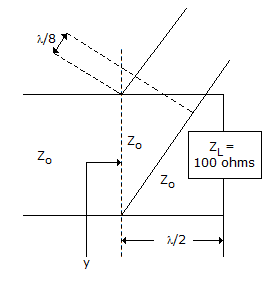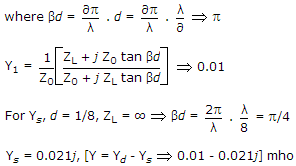Electronics and Communication Engineering - Electromagnetic Field Theory
Exercise : Electromagnetic Field Theory - Section 1
- Electromagnetic Field Theory - Section 1
- Electromagnetic Field Theory - Section 2
- Electromagnetic Field Theory - Section 3
- Electromagnetic Field Theory - Section 4
- Electromagnetic Field Theory - Section 5
- Electromagnetic Field Theory - Section 6
- Electromagnetic Field Theory - Section 7
- Electromagnetic Field Theory - Section 8
- Electromagnetic Field Theory - Section 9
- Electromagnetic Field Theory - Section 10
- Electromagnetic Field Theory - Section 11
- Electromagnetic Field Theory - Section 12
- Electromagnetic Field Theory - Section 13
26.
Consider a loss less antenna with a directive gain of + 6 dB. If 1 mW of power is fed to it the total power radiated by the antenna will be
Answer: Option
Explanation:
6 dB = 10 log10 

 = 100.6
= 100.6  3.98
3.98
Pr = 3.98 mW.
27.
A uniform plane wave is one in which
Answer: Option
Explanation:
For uniform plane wave, E and H must be in a plane but perpendicular to each other.
28.
The electric field of the incident wave is  , where ω = 3 x 109p and β = 10 p. The electric field of the transmitted wave Et is given by
, where ω = 3 x 109p and β = 10 p. The electric field of the transmitted wave Et is given by
 , where ω = 3 x 109p and β = 10 p. The electric field of the transmitted wave Et is given by
, where ω = 3 x 109p and β = 10 p. The electric field of the transmitted wave Et is given byAnswer: Option
Explanation:
In, question, it is not mentioned, about medium; dielectric etc.
Ei = Et + Er
 Et = Er
Et = Er
 Et =
Et =  Ei.
Ei.
29.
A short circuited stub is shunt connected to a transmission line as shown in the figure is, if z0 = 500 ohms, the admittance y seen at the function of the stub and the transmission line is


Answer: Option
Explanation:


30.
Which of the following should dominant wave have?
Answer: Option
Explanation:
Lowest cut off frequency or highest wave-length in a waveguide gives dominant modes.
Quick links
Quantitative Aptitude
Verbal (English)
Reasoning
Programming
Interview
Placement Papers
 x
x  = 0
= 0


